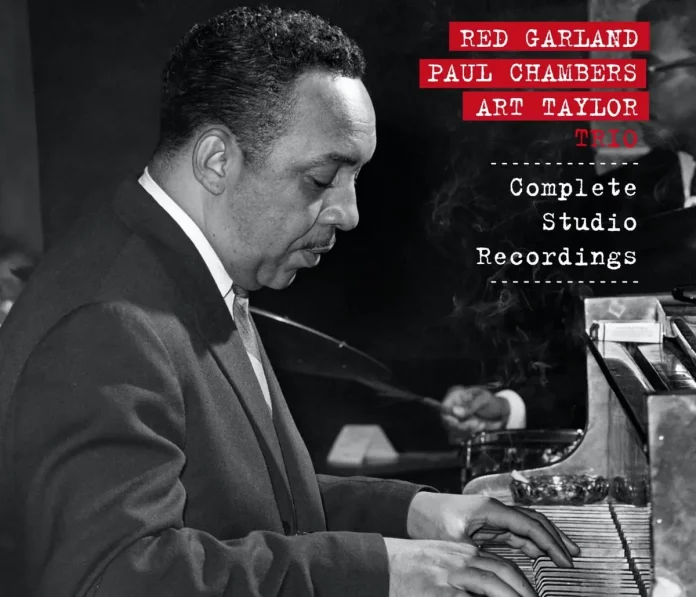And they are all here: Nine studio-recorded LPs on five CDs in a box with a comprehensive booklet. This is everything Garland recorded for Prestige with his trio (originally under just his own name).
Known and admired as the pianist in Miles Davis’s classic original quintet, Garland was one of the few jazz pianists of the 50s to have a separate recording contract with his own trio. He knew his trio partners well: Chambers was with him all through his years with Davis and Taylor was also in the MD quintet for a brief time in 1956.
Garland’s usual running mate, Philly Joe Jones, might have featured on the later discs here if he had not fallen out with Prestige boss Bob Weinstock. After that bust-up in November 1956, Philly never recorded again for Prestige. Taylor was more than adequate for the job, however, as he proves conclusively on these 57 tracks.
Red demonstrates his well-noted block-chord approach on many pieces but more of them feature his light, single note lines, at various tempi. He is most melodic on the single-line approach, his sound chime-like but never heavy. The block chords work well on slow to medium pieces like Makin’ Whoopee and Little Girl Blue.
He also demonstrates his ability to invent well at furious tempos, such as that adopted on Charlie Parker’s Constellation. Tunes Like If I Were A Bell and Billy Boy are similar to the versions he played on Davis’s quintet discs. The latter also shows the strong influence of Ahmad Jamal, something he shared with Davis.
Always a compulsive swinger, Garland shows on all these selections how well he integrated with Chambers and how helpful the bassist was in enhancing that swing. Taylor is also heard swinging briskly on slow, medium and uptempo songs.
It is all basic material, about 80 percent standards, but it is notable that the trio manage to get plenty of variety into their performances. Garland’s few originals are all blues and this trio were strong performers in that format. The P.C. Blues and Blues For Ann are good examples, both heavily featuring the Chambers bass.
Chambers is heard frequently playing his somewhat mournful arco lines, something he developed and practised more than any other bassist at the time. He was certainly a master with the bow but there are numerous pizzicato examples on offer too. Taylor was a sensitive, creative drummer and his solos were always well constructed and never overlong. He has several short workouts and sounds happy enough swapping fours with Garland on a number of tunes.
Although most record companies were recording in stereo by the middle of 1957, the first three CDs here are in mono. Not surprising perhaps as Bob Weinstock was more than careful with the pennies and managed to sell up and retire to Florida in his mid-40s! CDs 4 and 5 are recorded stereophonically and have some notable tracks: ’Tis Autumn and Stormy Weather, taken slowly, are good examples. Bass-Ment Blues is nearly all Chambers, and he also brightens up Four and Walkin’. These last two tunes on CD5 are the only ones to include a guest, Kenny Burrell on guitar, adding further variety.
There is a lot of music here and you probably need to be into jazz piano trio music to enjoy them fully. They demonstrate just how good Garland was as a soloist and rhythm-section leader and indicate the healthy state of bop piano during a golden age of the music.
Discography
CD1: A Foggy Day; My Romance; What Is This Thing Called Love; Makin’ Whoopee; September In The Rain; Little Girl Blue; Blue Red; Constellation; Willow Weep For Me; If I Were A Bell; I Know Why; What Can I Say; Please Send Someone To Love (79.38)
CD2: The Very Thought Of You; Stompin’ At The Savoy; Almost Like Being In Love; I Can’t Give You Anything But Love; Why Was I Born; But Not For Me; Billy Boy; It Could Happen To You; You Keep Coming Back Like A Song; Everybody’s Somebody’s Fool; I’m Afraid The Masquerade Is Over; Hey Now; Lost April (73.52)
CD3: Will You Still Be Mine; C Jam Blues; Gone Again; Tweedle Dee Dee; The P.C. Blues; Since I Fell For You; It’s A Blue World; Teach Me Tonight; This Can’t Be Love (78.43)
CD4: Crazy Rhythm; Portrait Of Jenny; I Can’t See For Lookin’; Soon; It Might As Well Be Spring; A Tisket, A Tasket; Black Out; Castle Rock; Bass-Ment Blues; T’ain’t Nobody’s Business (77.48)
CD5: And The Angels Sing; I’ll Never Stop Loving You; I Love You, Yes, I Do; Blues For Ann; ’Tis Autumn; Summertime; Spring Will Be A Little Late This Year; Stormy Weather; Winter Wonderland; Rain; Four; Walkin’ (79.21)
Garland (p); Chambers (b); Taylor (d). Kenny Burrell (elg) on Four and Walkin’ only. New Jersey, 17 August 1956 to 22 November 1958.
Essential Jazz Classics 55774















